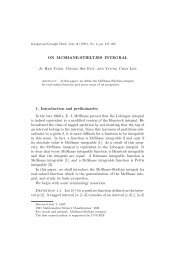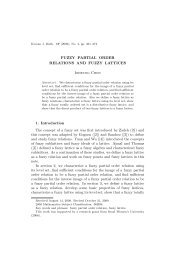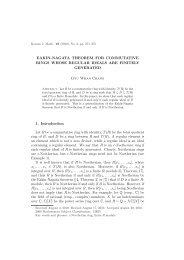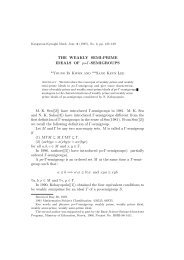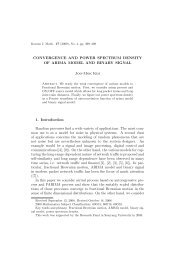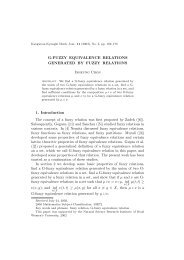Banach-Steinhaus properties of locally convex spaces
Banach-Steinhaus properties of locally convex spaces
Banach-Steinhaus properties of locally convex spaces
Create successful ePaper yourself
Turn your PDF publications into a flip-book with our unique Google optimized e-Paper software.
Kangweon-Kyungki Math. Jour. 5 (1997), No. 2, pp. 227–232<br />
BANACH-STEINHAUS PROPERTIES<br />
OF LOCALLY CONVEX SPACES<br />
Cui Chengri and Songho Han<br />
Abstract. <strong>Banach</strong>-<strong>Steinhaus</strong> type results are established for sequentially<br />
continuous operators and bounded operators between <strong>locally</strong><br />
<strong>convex</strong> <strong>spaces</strong> without barrelledness.<br />
In the past, all <strong>of</strong> <strong>Banach</strong>-<strong>Steinhaus</strong> type results have been established<br />
only for some special classes <strong>of</strong> <strong>locally</strong> <strong>convex</strong> <strong>spaces</strong>, e.g., barrelled<br />
<strong>spaces</strong> ([1,2,3]), s-barrelled <strong>spaces</strong> ([4]), strictly s-barrelled <strong>spaces</strong><br />
([5]), etc. Recently, Li Ronglu and Min-Hyung Cho ([6]) have obtained<br />
a <strong>Banach</strong>-<strong>Steinhaus</strong> type result which is valid for every <strong>locally</strong> <strong>convex</strong><br />
space as follows.<br />
Theorem 1 ([6], Th. B). Let (X, λ) and (Y, µ) be <strong>locally</strong> <strong>convex</strong><br />
<strong>spaces</strong> and T n : X → Y a λ − µ continuous linear operators, n ∈<br />
N. If lim n T n x = T x exists in Y, µ) for each x ∈ X, then the limit<br />
operator T is β(X, X ′ )-µ continuous and, in particular, continuous if<br />
X is barrelled.<br />
In this paper we would like to present <strong>Banach</strong>-<strong>Steinhaus</strong> type results<br />
for sequentially continuous operators and bounded operators and<br />
bounded operators between <strong>locally</strong> <strong>convex</strong> <strong>spaces</strong> without barrelledness<br />
requirement. By the agency <strong>of</strong> these results, we show that an<br />
important topology <strong>of</strong> uniform convergence on conditionally weak ∗ sequentially<br />
compact sets can be incompatible for some linear dual pairs.<br />
Let X and Y be <strong>locally</strong> <strong>convex</strong> <strong>spaces</strong>. An operator T : X → Y is<br />
said to be sequentially continuous if {x n } is a sequence in X such that<br />
x n → x, then T x n → T x; T is said to be bounded if T sends bounded<br />
sets into bounded sets. Clearly, continuous operators are sequentially<br />
continuous, and sequentially continuous operators are bounded but,<br />
Received July 10, 1997.<br />
1991 Mathematics Subject Classification: 47B37, 46A45.<br />
Key words and phrases: Barrelledness, Sequential Continuity, Boundedness.
228 Cui Chengri and Songho Han<br />
in general, converse implications fail. Let X ′ , X s and X b denote the<br />
families <strong>of</strong> continuous linear functions, sequentially continuous linear<br />
functionals and bounded linear functionals on X, respectively. In general,<br />
X ′ X s X b .<br />
For a linear dual pair (E, F ) let β(E, F ) denote the strongest (E, F )-<br />
polar topology on E which is just the topology <strong>of</strong> uniform convergence<br />
β(E,F )<br />
on σ(F, E)-bounded subsets <strong>of</strong> F . Thus, x a −−−−→ x if and only if for<br />
every σ(F, E)-bounded subset A <strong>of</strong> F , lim a f(x a ) = f(x) uniformly in<br />
f ∈ A.<br />
Theorem 2. Let X and (Y, µ) be <strong>locally</strong> <strong>convex</strong> <strong>spaces</strong> and T n :<br />
X → Y sequentially continuous linear operators, n ∈ N. If lim n T n x =<br />
T x exists in (Y, µ) for each x ∈ X, then the limit operator T is<br />
β(X, X s ) − µ continuous.<br />
Pro<strong>of</strong>. Every <strong>locally</strong> <strong>convex</strong> topology has a local base <strong>of</strong> neighborhoods<br />
<strong>of</strong> 0 which are barrels so µ is a (Y, Y ′ )-polar topology and, hence,<br />
there is a family F <strong>of</strong> σ(Y ′ , Y )-bounded subsets <strong>of</strong> Y ′ such that µ is<br />
just the topology <strong>of</strong> uniform convergence on sets in F.<br />
Let A ∈ F and x ∈ X. Since T n x → T x, lim n f(T n x) = f(T x)<br />
uniformly in f ∈ A and, hence, there is an n 0 ∈ N such that |f(T n x) <<br />
|f(T x)| + 1 for all f ∈ A and n ≥ n 0 . Observe that A is σ(Y ′ , Y )-<br />
bounded, there is an M > 0 such that sup f∈A |f(T x)| ≤ M and<br />
sup f∈A,1≤n≤n0 |f(T n x)| ≤ M. Therefore, sup f∈A,n∈N |f(T n x)| ≤ M +<br />
1, i.e., {f ◦ T n : f ∈ A, n ∈ N} is a σ(X s , X)-bounded subset <strong>of</strong> X s .<br />
β(X,X<br />
Now let {x k } be a sequence in X such that x s )<br />
k −−−−−→ x, and<br />
A ∈ F, ε > 0. Since {f ◦ T n : f ∈ A, n ∈ N} is σ(X s , X)-bounded,<br />
lim k f(T n x k ) = f(T n x) uniformly in both f ∈ A and n ∈ N. Hence<br />
there is a k 0 ∈ N such that<br />
|f(T n x k ) − f(T n x)| < ɛ 3 , ∀f ∈ A, n ∈ N, k ≥ k 0.<br />
Fix a k ≥ k 0 . Since lim n f(T n x k ) = f(T x k ) uniformly in f ∈ A and<br />
lim n f(T n x) = f(T x) uniformly in f ∈ A, there is an n 0 ∈ N such that<br />
|f(T n0 x k ) − f(T x k )| < ɛ 3 , |f(T n 0<br />
x) − f(T x)| < ɛ , ∀f ∈ A.<br />
3
<strong>Banach</strong>-<strong>Steinhaus</strong> <strong>properties</strong> <strong>of</strong> <strong>locally</strong> <strong>convex</strong> <strong>spaces</strong> 229<br />
Therefore,<br />
|f(T x k ) − f(T x)| ≤ |f(T x k ) − f(T n0 x k )| + |f(T n0 x k ) − f(T n0 x)|<br />
+ |f(T n0 x) − f(T x)| < ɛ 3 + ɛ 3 + ɛ , ∀f ∈ A.<br />
3<br />
This shows that lim k f(T x k ) = f(T x) uniformly in f ∈ A. Since<br />
A ∈ F is arbitrary, lim k T x k = T x in (Y, µ). Thus T is β(X, X s )-µ<br />
sequentially continuous. □ □<br />
A linear dual pair (E, F ) is said to be <strong>Banach</strong>-Mackey if σ(E, F )-<br />
bounded subsets <strong>of</strong> E are β(E, F )-bounded, i.e., {f(x) : x ∈ B, f ∈ A}<br />
is bounded for every σ(E, F )-bounded subset B <strong>of</strong> E and σ(F, E)-<br />
bounded subset A <strong>of</strong> F . A <strong>locally</strong> <strong>convex</strong> space X is called a <strong>Banach</strong>-<br />
Mackey space if (X, X ′ ) is <strong>Banach</strong>-Mackey. It is easy to see that for<br />
subsets <strong>of</strong> a <strong>locally</strong> <strong>convex</strong> space X the σ(X, X ′ )-boundedness, the<br />
σ(X, X s )-boundedness and the σ(X, X b )-boundedness are equivalent.<br />
Hence if X is not <strong>Banach</strong>-Mackey, i.e., (X, X ′ ) is not <strong>Banach</strong>-Mackey,<br />
both (X, X s ) and (X, X b ) are not <strong>Banach</strong>-Mackey because X ′ ⊂ X s ⊂<br />
X b . This shows that (X, X b ) is not <strong>Banach</strong>-Mackey for many <strong>locally</strong><br />
<strong>convex</strong> <strong>spaces</strong>. A recent result due to Li Ronglu and C. Swartz ([7],<br />
Th. 8) can be stated in the following way.<br />
Proposition 3. Let X be a <strong>locally</strong> <strong>convex</strong> space. The followings<br />
are equivalent.<br />
(1) (X, X b ) is <strong>Banach</strong>-Mackey.<br />
(2) If {f n } ⊂ X b and lim n f n (x) = f(x) exists at each x ∈ X, then<br />
the limit functional f is in X b .<br />
Now let X and Y be <strong>locally</strong> <strong>convex</strong> <strong>spaces</strong> and T n : X → Y bounded<br />
linear operators for n ∈ N. Proposition 3 shows that the limit operator<br />
T can be unbounded even if T n x → T x at each x ∈ X, i.e., T (B) can<br />
be unbounded for some bounded B ⊂ X. Hence we would like to show<br />
that for some kind <strong>of</strong> bounded set B, T (B) must be bounded. To see<br />
this we recall that in a duality pair (E, F ) a subset A <strong>of</strong> F is said to be<br />
conditionally σ(F, E)-sequentially compact if every sequence {f n } in<br />
A has a subsequence {f nk } such that lim k f nk (x) exists at each x ∈ E.<br />
Let η(E, F ) denote the topology <strong>of</strong> uniform convergence on conditionally<br />
σ(F, E)-sequentially compact subsets <strong>of</strong> F . P.Dierolf ([8]) has
230 Cui Chengri and Songho Han<br />
shown that in the case <strong>of</strong> linear dual pair (E, F ) the topology η(E, F )<br />
and the weak topology σ(E, F ) have the same subseries convergent<br />
series.<br />
Theorem 4. Let X and Y be <strong>locally</strong> <strong>convex</strong> <strong>spaces</strong> and T n : X → Y<br />
bounded linear operators, n ∈ N. If weak-lim n T n x = T x exists at each<br />
x ∈ X, then the limit operator T sends η(X, X b )-bounded sets into<br />
bounded sets.<br />
Pro<strong>of</strong>. Let y ′ ∈ Y ′ . Then lim n y ′ (T n x) = y ′ (T x) for each x ∈ X so<br />
{y ′ ◦ T n : n ∈ N} is conditionally σ(X b , X)-sequentially compact. Suppose<br />
that B is a η(X, X b )-bounded subset <strong>of</strong> X and {x k } ⊂ B. Then<br />
η(X,X b )<br />
1<br />
k x k −−−−−→ 0, so for every y ′ ∈ Y ′ 1<br />
lim k k y′ (T n x k ) = 0 uniformly in<br />
n ∈ N.<br />
Now fix an y ′ ∈ Y ′ and ɛ > 0. There is a k 0 ∈ N such that<br />
∣ 1<br />
k y′ (T n x k ) ∣ <<br />
ɛ<br />
2 for all n ∈ N and all k ≥ k 0. Fix a k ≥ k 0 . Since<br />
lim n y ′ (T n x k ) = y ′ (T x k ) there is an n 0 ∈ N such that |y ′ (T n0 x k ) −<br />
y ′ (T x k )| < ɛ 2 . Therefore,<br />
| 1 k y′ (T x k )| ≤ | 1 k y′ (T x k ) − 1 k y′ (T n0 x k )| + | 1 k y′ (T n0 x k )| < ɛ<br />
2k + ɛ 2 ≤ ɛ.<br />
This shows that {y ′ (T x) : x ∈ B} is bounded. Since y ′ ∈ Y ′ is arbitrary,<br />
{T x : x ∈ B} is bounded in Y by the classical Mackey theorem.<br />
□ □<br />
Let us denote by θ(X, X b ) the topology <strong>of</strong> uniform convergence on<br />
σ(X b , X)-Cauchy sequences in X b . A subset B <strong>of</strong> X is said to be<br />
θ(X, X b )-bounded if for every sequence {x k } in B and every σ(X b , X)-<br />
Cauchy sequence {f n } in X b 1<br />
, lim k k f n(x k ) = 0 uniformly in n ∈ N.<br />
Then the pro<strong>of</strong> <strong>of</strong> Theorem 4 gives the following.<br />
Theorem 5. Let X and Y be <strong>locally</strong> <strong>convex</strong> <strong>spaces</strong> and T n : X → Y<br />
bounded linear operators, n ∈ N. If weak-lim n T n x = T x exists at<br />
each x ∈ X, then the limit operator T sends θ(X, X b )-bounded sets to<br />
bounded sets.<br />
Now we have a useful proposition as follows.
<strong>Banach</strong>-<strong>Steinhaus</strong> <strong>properties</strong> <strong>of</strong> <strong>locally</strong> <strong>convex</strong> <strong>spaces</strong> 231<br />
Theorem 6. For a <strong>locally</strong> <strong>convex</strong> space X the following conditions<br />
are equivalent.<br />
(1) For every <strong>locally</strong> <strong>convex</strong> space Y and for every sequence {T n }<br />
<strong>of</strong> bounded linear operators from X into Y such that weaklim<br />
n T n x = T x exists at each x ∈ X, the limit operator T is<br />
also bounded.<br />
(2) (X b , σ(X b , X)) is sequentially complete.<br />
Pro<strong>of</strong>. (1)=⇒(2). Let {f n } be a σ(X b , X)-Cauchy sequence in X b .<br />
Then lim n f n (x) = f(x) exists at each x ∈ X and f ∈ X b by (1).<br />
(2)=⇒(1). Let Y be a <strong>locally</strong> <strong>convex</strong> space and {T n } a sequence <strong>of</strong><br />
bounded linear operators form X into Y such that weak-lim n T n x = T x<br />
exists at each x ∈ X. Suppose that B is a bounded subset <strong>of</strong> X and<br />
y ′ ∈ Y ′ . Then lim n y ′ (T n x) = y ′ (T x) at each x ∈ X. Since y ′ ◦T n ∈ X b<br />
for all n ∈ N, y ′ ◦ T ∈ X b by (2). Therefore {y ′ (T x) : x ∈ B} is<br />
bounded and hence {T x : x ∈ B} is bounded in Y by the classical<br />
Mackey theorem. □ □<br />
A <strong>locally</strong> <strong>convex</strong> space X is said to be semibornological if X ′ = X b .<br />
Let ϕ be a family <strong>of</strong> number sequences such that each {t j } ∈ ϕ has<br />
only finite many <strong>of</strong> nonzero t j . With the norm ‖{t j }‖ ∞ = sup j |t j |,<br />
X = (ϕ, ‖ · ‖ ∞ ) is a noncomplete normed space. It is easy to see<br />
that X ′ = X b = 1 1 , i.e., X is semibornological, and (X b , σ(X b , X)) =<br />
(X ′ , σ(X ′ , X)) = (1 1 , σ(1 1 , ϕ)) is not sequentially complete. By Theorem<br />
6, there exists a <strong>locally</strong> <strong>convex</strong> space Y and a sequence {T n }<br />
<strong>of</strong> bounded linear operators such that weak-lim n T n x = T x exists at<br />
each x ∈ X but the limit operator T is not bounded., i.e., T (B 1 ) is<br />
unbounded in Y for the unit ball B 1 <strong>of</strong> X. Now by Theorem 4, B 1 can<br />
not be η(X, X b )-bounded, i.e., B 1 is not η(X, X ′ )-bounded because<br />
X ′ = X b = 1 1 . Thus, we have the following interesting fact.<br />
Corollary 7. For a linear dual pair (X, X ′ ) the polar topology<br />
η(X, X ′ ) need not be compatible, e.g., η(ϕ, 1 1 ) is not compatible.<br />
References<br />
[1] J. Horvath, Topological vector <strong>spaces</strong> and distributions, Addison-Wesley, 1966.<br />
[2] A. Wilansky, Modern Methods in TVSs, McGraw-Hill, 1978.<br />
[3] G. Kothe, Topological Vector Spaces, I, Springer-Verlag, 1983.
232 Cui Chengri and Songho Han<br />
[4] R. Snipes, S-barrelled topological vector <strong>spaces</strong>, Canad. Math. Bull. 21 (1978),<br />
no. 2, 221–227.<br />
[5] W.H. Hsiang, <strong>Banach</strong>-<strong>Steinhaus</strong> theorems <strong>of</strong> <strong>locally</strong> <strong>convex</strong> <strong>spaces</strong> based on<br />
sequential equicontinuity and essentially uniform boundedness, Acta Sci. Math.<br />
52 (1988), 415–435.<br />
[6] Li Ronglu and Min-Hyung Cho, <strong>Banach</strong>-<strong>Steinhaus</strong> type theorem which is valid<br />
for every <strong>locally</strong> <strong>convex</strong> space, Appl. Funct. Anal. 1 (1993), 146–147.<br />
[7] Ronglu and C. Swartz, Characterizations <strong>of</strong> <strong>Banach</strong>-Mackey space, Chinese J.<br />
Math. 24 (1996), no. 2, 199-210.<br />
[8] P. Dierolf, Theorems <strong>of</strong> the Orlicz-Pettis-type for <strong>locally</strong> <strong>convex</strong> <strong>spaces</strong>, Manuscripta<br />
Math., 20 (1977), 73–94.<br />
Cui Chengri<br />
Department <strong>of</strong> Mathematics<br />
Harbin Institute <strong>of</strong> Technology<br />
Harbin, China;<br />
Department <strong>of</strong> Mathematics<br />
Yanbian University<br />
Yanji, China<br />
Songho Han<br />
Department <strong>of</strong> Mathematics<br />
Kangwon National University<br />
Chuncheon 200-701, Korea



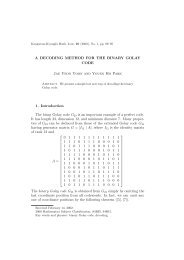
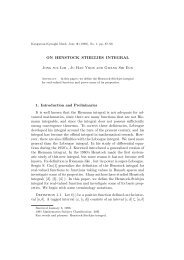
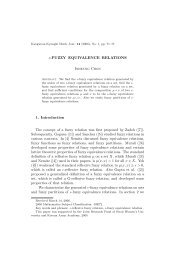
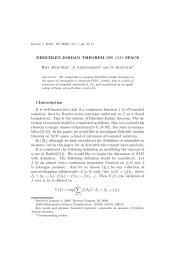

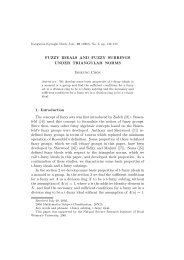
![SEMI-REGULAR po-SEMIGROUPS SK Lee J. Calais([1])](https://img.yumpu.com/46211509/1/184x260/semi-regular-po-semigroups-sk-lee-j-calais1.jpg?quality=85)
